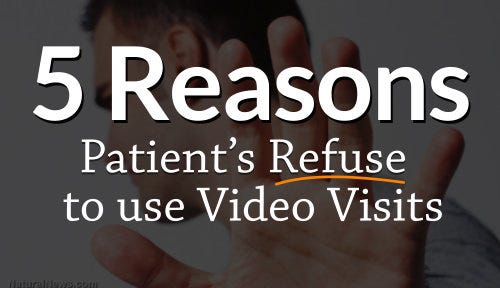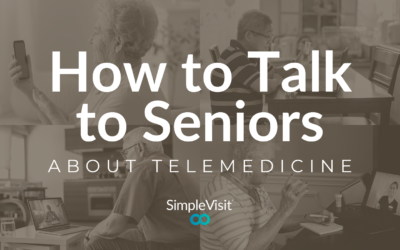
5 Reasons Patients Refuse to use Video Visits
While the future is bright in the world of telemedicine, the harsh truth remains: many of the patients best suited to use telemedicine are uncomfortable or unable to use it. As we are ushered into the age of telehealth, it is critical to understand the user challenges facing patients who are transitioning to a world of connected care. Only by understanding the struggles of patients that are causing poor user adoption can we build products and supply the care of the future. So without further ado, here are the top 5 reasons I have seen for patients who refuse to use telehealth.

Reason #1 “I want to see my Doctor.”
The first reason may be obvious: the patient’s doctor doesn’t offer telemedicine. While this problem will resolve as more providers jump on the telemed bandwagon, it should be noted that this will only resolve as existing providers integrate telemedicine into their practice. Patients should not be put in the position of deciding to leave their current doctor for a purely virtual, yet convenient experience. However, early indication is that when patients are put into this position, it may not be so obvious that they will remain loyal to their provider, as one in five patients would leave their provider for one that offers virtual care.
This decision is one patients are increasingly having to make as insurance companies push patients to see providers that offer telehealth services. In conclusion, don’t be the doctor that delays adapting until it is too late, because the choice of seeing a virtual doctor or your personal doctor is becoming harder and harder.
Reason #2 “The camera doesn’t like me.”
The next hurdle we have observed in telemedicine users is that they feel uncomfortable seeing a provider over video. The medical visit is often a very private and intimate circumstance, so the added awkwardness of doing it over a video application is too much for some to handle.
However this innate fear of technology is not an insurmountable barrier. A recent study says 64% of patients said they were open to the idea of video visits. As patients begin to understand the added convenience and level of security involved in video visits, their willingness will improve. Practices often assume their patients were uninterested or “weirded out” by video visits, only to find upon deeper digging that the patient’s fear was stemming in lack of understanding or a perception of lack of privacy. In fact, it is more common than not to see a physician predict a patient having an adverse reaction, than a patient actually having one. With good communication providers can help put the fears of patients to rest.
Reason #3 “Is there a manual for this thing?”
The next reason is less a result of human need, and more so a result of technological shortcomings of healthtech makers. Poor connections, multiple log-ins, and confusing downloads are some of the most common complaints from patients new to telemedicine. It is common to see telemedicine technology that promises to do it all, but proves to be overwhelming for patients who may be new to applications and video technology. As vendors, we must focus on the patient experience. It is not enough in this era to simply offer video technology. We must strive to create simple and engaging visits that make the patients feel safe, while providing functionality to providers.
Only once we focus on curating virtual visits that meet the needs of patients and providers can we hope to find widespread adoption. This starts with improved technology design and ends with comprehensive provider training and patient on-boarding.
Reason #4 “I didn’t even know that was an option.”
Lack of awareness is another challenge many patients face when asked about video visits. A marketing challenge for many telemedicine providers seems to be getting patients to buy into converting visits into virtual. Often patients do not think about how they get their healthcare until it is time to utilize it, which means telehealth providers must be proactive in their attempt to inform patients of their services. Unlike a hospital or urgent care center where the patient may naturally encounter or be recommended to the location for care, the virtual care experience is a hidden gem which must be discovered. It is incredible to think about the amount of heavy internet and mobile application users who have no idea whether or not their provider or insurance offers them access to virtual care. As the push to mass market continues and regulation softens, we should expect to see a rise in consumer awareness and technology utilization.
Reason #5 “How much does it cost?”
The last barrier holding patients from virtual consults is cost. When given the choice of a $20 copay on a visit to their PCP or a $50 virtual consult, the patient’s choice should be obvious. This is not news, as public and private insurers have felt pressure for years to conform and offer enhanced options for those seeking virtual care. While it is a slow grind, costs are falling and the option to get coverage for video visits are improving. Only once we can reach parity or discounted rates for visits conducted over video should we expect to see mass adoption mass consumers.
So as we push forward into the age of digital health, telemedicine solutions would do well to consider these barriers common to the patient experience. Enough with poor products that promise the world and deliver on little. And enough of the in house solutions that are made for an enterprise and then marketed to consumers. Let us learn from other markets, by producing products that our patients actually want!
About SimpleVisit
SimpleVisit is a video service which allows patients and providers to connect over the video platform of their choice. With SimpleVisit providers are able to deliver on-demand visits to patients over any device or platform they have available to them. For more information on SimpleVisit and on how we are enabling providers to host virtual visits check out www.SimpleVisit.com
How to Talk to Seniors (About Telemedicine)
Allie Clark | 10 min read | November 13, 2020In the midst of an unprecedented healthcare crisis, it’s important to be mindful of some of the most vulnerable members in our communities: our seniors. This particular season has been uniquely challenging for older...
The Journey Through
Allie Clark | 10 min read | October 28, 2020The lingering uncertainty of the pandemic in America is causing consumers and practitioners to adjust and re-adjust expectations for healthcare delivery. Regulators are changing their stance on privacy and coverage...
How to Launch a Successful Telemedicine Program
Rob Warlick | 5 min read | October 13, 2020Telemedicine has moved beyond intriguing to imperative in a short amount of time. Medical groups across the country are faced with the challenge to build and maintain a successful telemedicine program simply to retain their...



